The hotel served an excellent and varied breakfast in the ground floor restaurant which occupies a light and airy modern conservatory at the rear of the property. I'd purchased a Museum Pass from the helpful receptionist Utkan. This credit card sized pass gives entry to all the government museums in Istanbul for five days from first use. These museums open at 9.00 o'clock and I'd hoped to start early worrying that visitor numbers would increase later.
I determined to visit Hagia Sophia Museum first, which I estimated would be perhaps a 15 minute walk from the hotel. The site was already busy when I arrived but, having purchased a Museum Pass, I quickly gained entry.
Hagia Sophia Museum
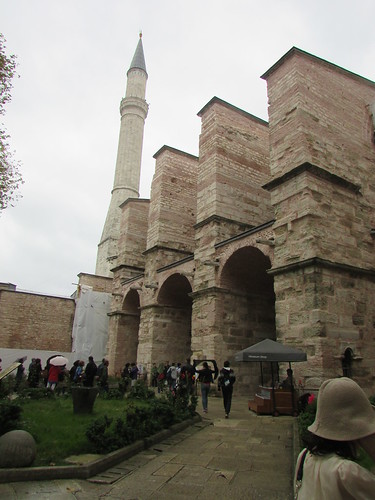
Hagia Sophia Museum, Istanbul: The public entrance. Note the massive buttresses.
Since its inauguration in 537 A.D. as a Byzantine Christian Cathedral, it has variously served as a Roman Catholic Cathedral, Greek Orthodox Cathedral and, for 478 years, as an Ottoman Mosque until turned into a museum by the secularist Kemal Ataturk in 1935. There is currently a movement to restore its religious use.
Entering the nave, I was I immediately impressed with the sheer scale of the building and its huge main dome.
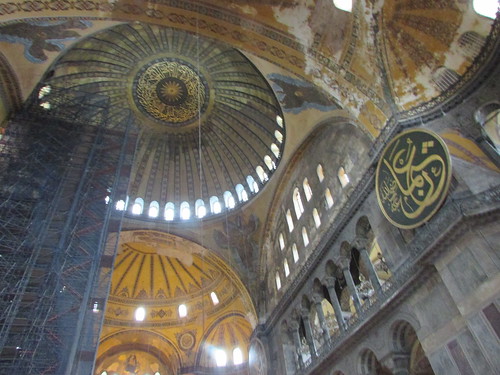
Hagia Sophia Museum, Istanbul: The blue scaffolding is used for ongoing conservation work. Note how the weight of the windowed dome is transferred by 'pendentives' (3-sided portions of a sphere) onto four main pillars. In the background, one of two abutted 'semi-domes' resulting in a rectangular nave area.
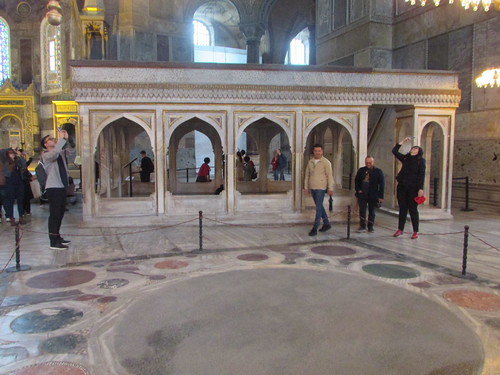
Foreground: Omphalion (place of coronation of Emperors), rear: Muezzins' Loge, Hagia Sophia Museum, Istanbul
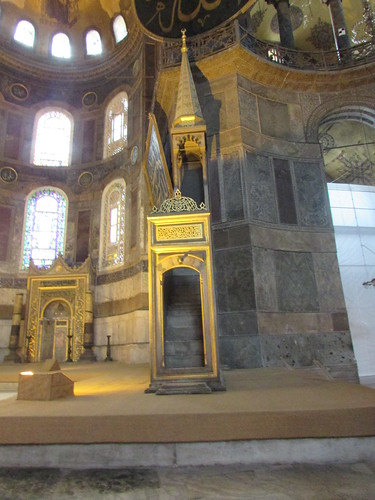
Minbar (pulpit for Imam), Hagia Sophia Museum, Istanbul
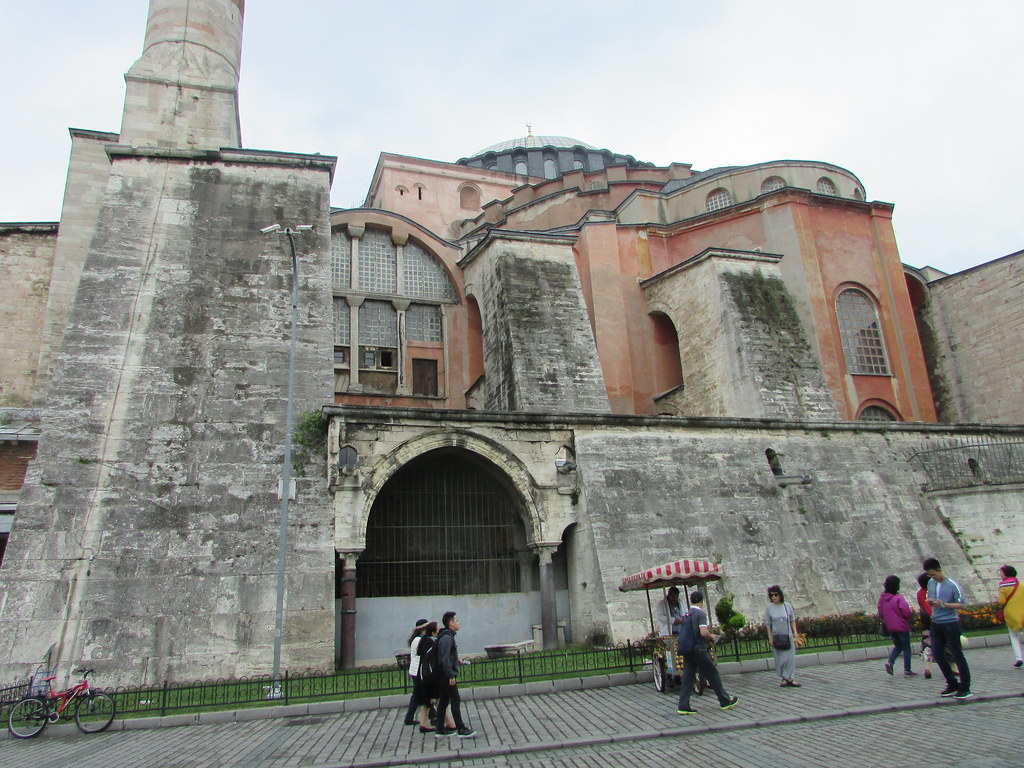
Hagia Sophia Museum, Istanbul: showing Flying buttresses.
I could have spent much longer here but I was anxious to move on before I became too tired.
Topkapi Palace Museum
It didn't take me long to walk from Hagia Sophia to the adjacent Great Square with the Sultan Ahmet III Fountain in front of the imposing Imperial Entrance to the gardens of the walled First Courtyard of Topkapi Palace.

Great Square, Istanbul: Left rear: Imperial Gate (leading to First Courtyard) Right foreground: Sultan Ahmed III Fountain.
Sultan Mehmed II conquered Istanbul in 1453 and commissioned the building of Topkapi as a Palace and Administrative Centre, replacing (or incorporating) earlier construction. Its irregular layout with disparate buildings and pavilons was unlike other European or Oriental palaces. The site is divided into four courtyards and the Harem but during my exploration I didn't have the useful 5-page plan which can be found on the official website here.
Topkapi was used by the Ottoman Rulers from 1478 to 1853 but, in 1843, Sultan Abdulmecid I decided that a medieval palace was no longer appropriate and he commissioned the building of the Dolmabahce Palace overlooking the Bosphorus in the European Rococo style.

Bosphorus Cruise: Dolmabahce Palace in the European Rococo style, built between 1843 and 1856.
As soon as the new palace was completed in 1856, Topkapi became accommodation for 'ranked officers'. With independence in 1924, Kemal Ataturk made Topkapi a public museum, in an action signifying a 'new beginning' for Turkey.
In the First Courtyard I found quite a 'scrum' of people buying admission tickets but, with my Museum Pass, I was able to skip this and head directly through the electronic admission gate at the Gate of Salutation where there was a cursory, friendly security check and then I was free to explore.
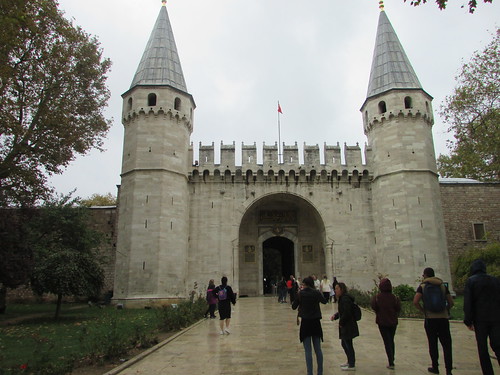
The Gate of Salutation, leading to Second Courtyard, Topkapi Palace Museum, Istanbul
Sultan Mehmed II established protocols to ensure his seclusion, including strict silence in the inner courtyards and, even today, I found the gardens of the courtyards pleasant and tranquil (although I admit I tended to avoid the busier areas like the exhibitions in the Outer Treasury).

Topkapi Palace Museum, Istanbul: Second Courtyard L: Imperial Council, R: Outer Treasury, Rear: Tower of Justice.
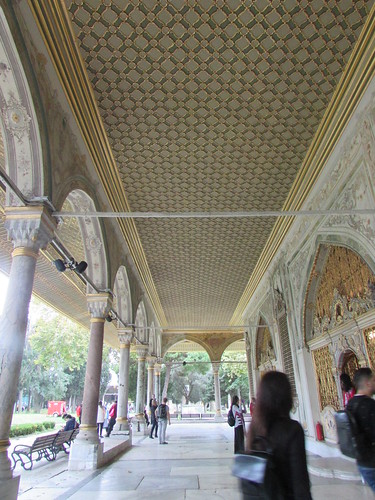
Topkapi Palace Museum, Istanbul: Imperial Council Building.
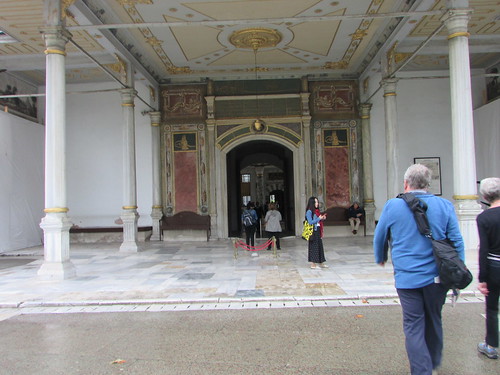
Topkapi Palace Museum, Istanbul: Entrance to the Third Courtyard through the Gate of Felicity.
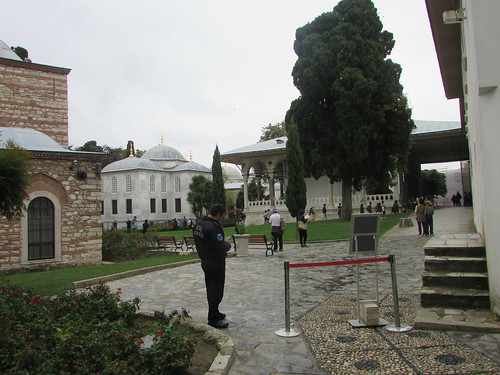
Topkapi Palace Museum, Istanbul: The Third Courtyard. The white, domed building is the Library of Ahmed III with the Audience Chamber to the right.
For some reason, admission to the Harem is not included in the basic 'Topkapi' ticket but with my 'All Areas' Museum Pass, that was not a problem. However, whilst I hope I'm not a strident feminist, I do have a problem with both the historic and current position of women in some societies although the Harem is currently presented as private accommodation for the Sultan and his extended family. So I was keen to visit the Harem. It's a large, rabbit-warren of a place with over 300 rooms and, in general, lower standards of decoration seemed to apply although rooms used by the Sultan were fairly grand. Some of the areas struck me as more gloomy and gaol-like than the tranquil courtyards I'd enjoyed earlier (or perhaps my prejudices are showing).
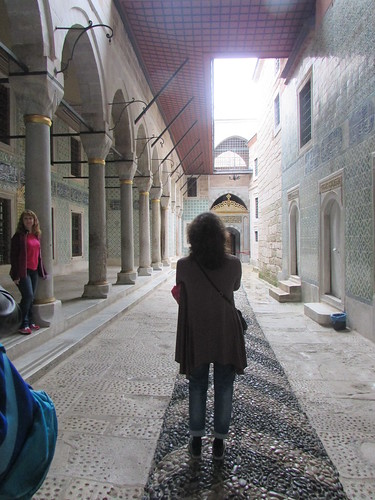
Topkapi Palace Museum, Istanbul: The Harem.
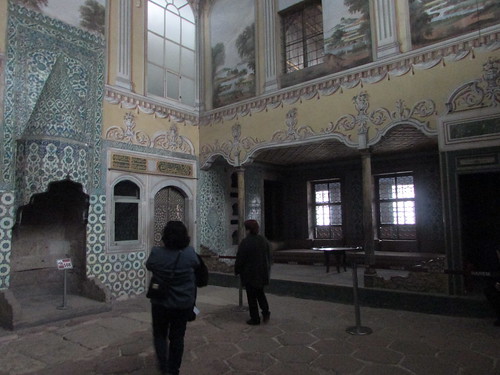
Topkapi Palace Museum, Istanbul: The Apartments of the Queen Mother.
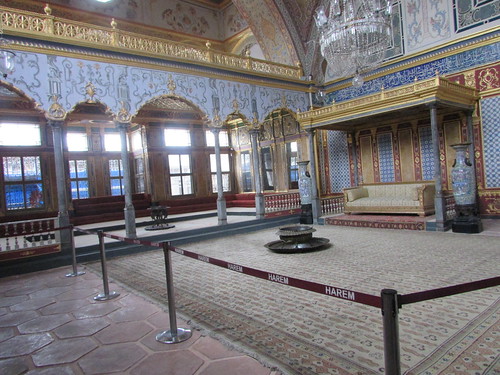
Topkapi Palace Museum, Istanbul: Imperial Hall with Throne of the Sultan.

Topkapi Palace Museum, Istanbul: Privy Chamber of Sultan Murad III. Built in 1578, it is an important example of Ottoman architecture.

Topkapi Palace Museum, Istanbul: The Courtyard of the Favourites in the Harem.
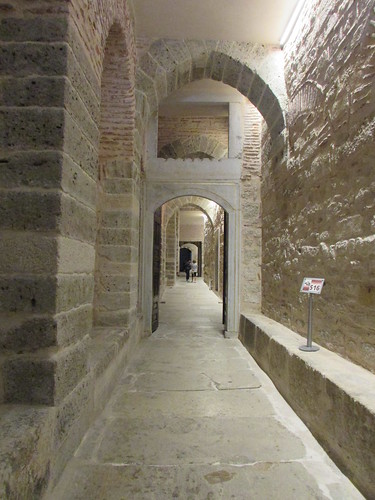
Topkapi Palace Museum, Istanbul: The 'Golden Road' passage in the Harem.
It would take days to do justice to this museum but I did form the impression that the Ottoman Rulers enjoyed quite an agreeable lifestyle in the pleasant surroundings of Topkapi. Because of its strategic location, controlling the trade route connecting the Black Sea and the Mediterranean, Istanbul has always been important, during Greek, Roman, Byzantine, Ottoman and modern eras. The detailed history is very complex but I afterwards found a fascinating animation on YouTube here titled 'The History of Anatolia - Year by Year'. 'Anatolia' is roughly similar to modern Asian Turkey and was the homeland of what expanded to become the Turkish or Ottoman Empire. However, worried that I would become over-tired touring Topkapi Palace, I decided to leave after just a fascinating glimpse, with the intention of walking back to my hotel to rest. It was pleasant walking through the old streets but, when I came upon the entrance of the archaeological museum the principle of "I may never pass this way again" kicked-in and I decided I should at least make a brief visit.
Archaeological Museum
Opened in 1891 this is a large museum with over one million Greek, Roman and Byzantine artifacts. It's currently undergoing fairly major reconstruction limiting what is on display but I nevertheless found it fascinating. It's very much a 'traditional' museum - exhibits you can walk right up to, with just a card in Turkish and English by way of interpretation. Being rather old-fashioned this suited me very well.
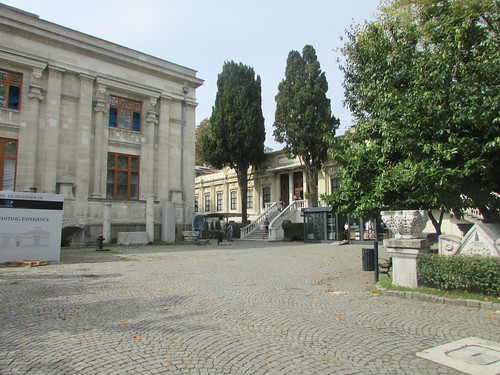
Museum of Archaeology, Istanbul
In the museum grounds, there was a reconstruction of a 9th century trading ship 10m long, lateen rigged, based on evidence from a shipwreck excavated in Theodosian Harbour. The lateen rig is used in the Eastern Mediterranean and in Egypt on the felucca design, so I was reminded of the felucca trips I'd enjoyed in Egypt (posts here and here).
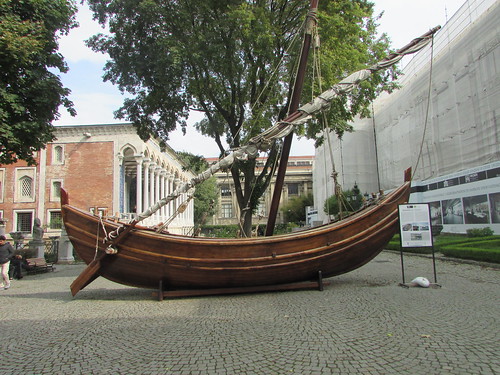
Museum of Archaeology, Istanbul: A reconstruction of a 9th century trading ship 10m long, lateen rigged, based on evidence from a shipwreck excavated in Theodosian Harbour.
The were displays on various topics - the perennial water supply problems, the Golden Horn Chain, the 19th century restoration of Hagia Sophia by the Fossati Brothers.
Elaborate aqueducts were originally used to bring in water, feeding hundreds of open and enclosed cisterns with tubular carved stone water mains.
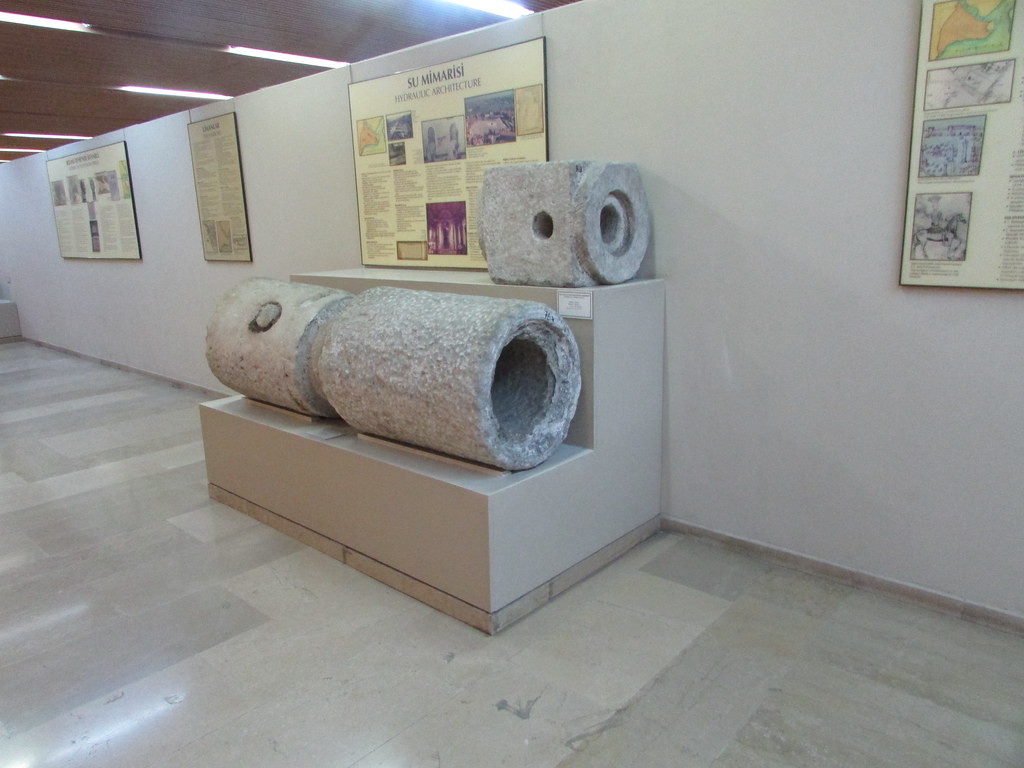
Museum of Archaeology, Istanbul: Sections of carved marble water mains.
The Golden Horn Chain was a large chain pulled across from Constantinople to the old Tower of Galata to prevent unwanted ships from entering the Golden Horn Moorings.
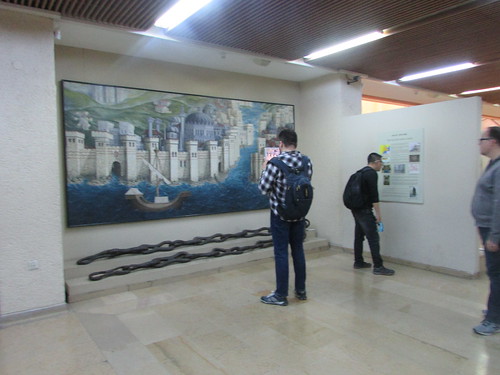
Museum of Archaeology, Istanbul: Remains of the Golden Horn Chain, used to close-off the moorings of the Golden Horn to enemy ships and a painting showing fortified Constantinople.
Various artifacts from different periods were on display, such as this section of a Babylonian ceremonial procession street featuring repeated lions in relief. The original was 300 metres long.

Section of Babylonian ceremonial procession street featuring repeated lions in relief.
Perhaps most impressive was the profusion of Greek and Roman statuary. There were so many important works (and so many visitors) that I'm afraid I didn't attempt photography. So I reluctantly left the museum and slowly walked back to my hotel (pausing to top-up my Instanbulkart with some help from a friendly local in the hope that my energy level would revive). The hotel restaurant was able to provide a wonderful soup with a selection of fresh bread and a Coca-Cola, after which I felt much better and started to plan more exploration for the afternoon.
Related posts on other websites
Hagia Sophia Museum
It's worth looking at the Wikipedia article here and the Hagia Sophia Museum Website here (in particular, the links at the bottom of the home page to History/Interior/Exterior).
Topkapi Palace Museum
For more information, see the Wikipedia article here (there's a detailed plan of the Harem and a number of excellent photographs here) or the Topkapi Palace Museum Website here (there's a brief history here, an architectural summary here, information on the various collections here) and a 5-page plan of the site here.
Archaeological Museum
There's a Wikipedia article here.
The Ministry of Culture and Tourism has a site here.
Related posts on this website
This is one of a number of posts describing my weekend in Istanbul, starting with Arriving in Istanbul.
Clicking on the 'Next report' link displays the post describing the next events. In this way, you may read about the weekend in sequence.
Next report.
Alternately, clicking on the 'All my Istanbul reports' link displays all the posts on this weekend in reverse date-of-posting order.
All my Istanbul reports.
My pictures
Istanbul, Turkey.
Hagia Sophia Museum, Istanbul.
Topkapi Palace Museum.
Museum of Archaeology, Istanbul.
All my pictures in Turkey.
